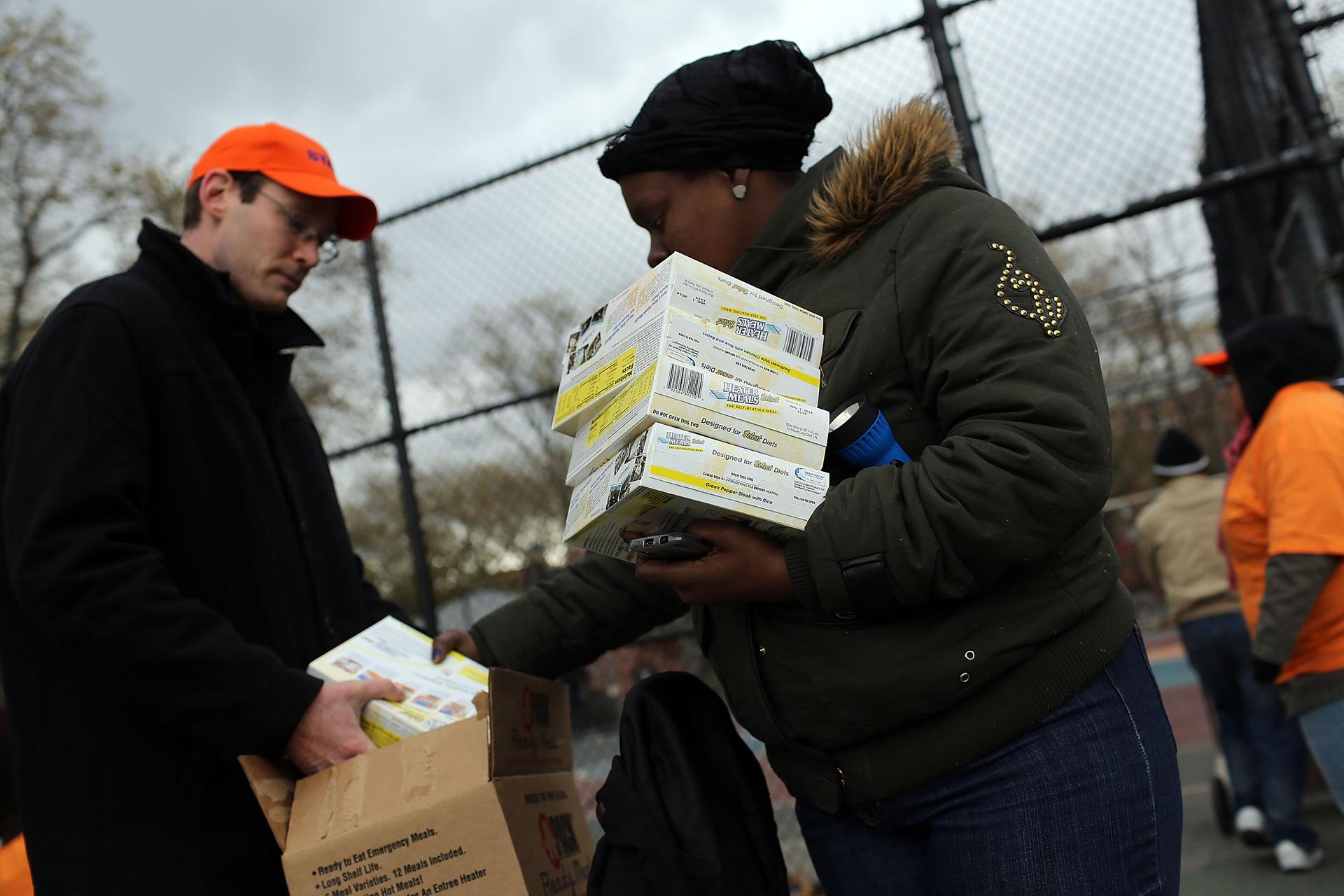Hurricane Sandy spotlights Brooklyn inequality: Thousands still without basic utilities as more affluent neighbors recover
A woman recieves donated water and ready-to-eat meals at the Red Hook Houses project in Brooklyn where there is currently limited water and electricity due to Hurricane Sandy on November 2, 2012 in the Brooklyn borough of New York City.
BROOKLYN, New York — The New York City Housing Authority confirmed Wednesday that 4,000 of the roughly 6,000 housing project residents of Red Hook are still without heat and water, knocked out more than a week ago by Hurricane Sandy.
With a snowy Nor’easter slamming the area Wednesday, about 3,500 of those residents are also without electricity, throwing into stark contrast the disparity built into the socially and economically diverse population of this low-lying waterfront Brooklyn neighborhood now considered charming and up-and-coming.
Red Hook suffered some of New York’s most severe damage from Sandy, with more than five feet of water inundating most of the local businesses and residences. Although the water receded and the streets began to dry within a day or two after the storm, the delicate and uneven recovery from the significant damage captures a dramatic picture of inequality here.
GlobalPost has termed the increasing income inequality in America’s metropolitan areas a “Great Divide.” The New York City metropolitan area has a Gini coefficient of .503, which makes it comparable to the countries of Ecuador, Nigeria and Zimbabwe.
To paint a picture, on one side of Red Hook’s central Van Brunt Street, artist Dustin Yellin operates out of a $3.7 million restored Civil War-era factory which houses his works, valued at up to several hundred thousand dollars each.
Yellin and many of his neighbors, including the string of Van Brunt’s restaurants, bars and shops, represent the more recent influx of affluence in a neighborhood that was once noted for severe poverty and gang and drug related violence. It was listed as one of the worst neighborhoods in the United States and the “crack capital of America” by LIFE Magazine in the late 1980s.
The community’s newfound affluence is piecemeal. Just a few blocks away from Yellin, on the other side of Van Brunt Street, Red Hook hosts the largest project housing development in Brooklyn with over 2,800 apartments. Sandy, of course, hit everyone and left in its wake a dramatization and unavoidable spotlight on lifestyle inequities in a community at the peak of gentrification.
About half of the area including many of the businesses on Van Brunt have recovered power, and a few have even reopened. Several restaurants and bars remain closed indefinitely due to extensive damage. Baked, a coffee shop, reopened Thursday after the storm and its neighbor restaurant, Hope and Anchor, opened the next evening.
“We wanted to open as soon as possible. It feels good to be open for the community,” said Pete Ascolese, owner of Hope and Anchor. Restore Red Hook was organized as a portal to centralize efforts in support of keeping the area’s small businesses afloat post-Sandy.
Thanks in large part to a strong community effort, things are slowly recovering and there seems to be some life on Van Brunt Street.
Recovery in the Red Hook East and Red Hook West project housing buildings just a few blocks over is a less promising picture. Volunteers are actively delivering supplies and providing shelters and warming centers.
“The volunteers have done more for us than the housing association,” said one Housing Authority resident. But there is no escaping the hard facts: thousands of residents, most those in the projects, are still without power as a “Nor’easter” brings freezing temperatures, wind and rain, to many residents left without basic utilities.
Angel Ylufo, who lives in a high-rise project housing building on Dwight Street, expressed frustration with the state and allocation of recovery efforts in Red Hook.
“I’ve got no power, no water and can smell sewage in my building and there is definitely more attention to the local businesses than for us in the projects. I’m all for local business, but what about the rest of us citizens who are living here?”
Voter turnout was expected to be challenged by the still-dire state of Red Hook’s recovery.
“I have spoken to a lot of people in the projects who have told me they are not going to vote because of this,” said Ylufo, age 45. “I think especially a large percentage of the older (project residents) will not be voting. It’s a lot for them to climb down 14 floors without heat or water.”
However, some residents expressed intentions to get the vote out despite the bleak state. Jasmine Hazzard, 25, who lives in a project housing building adjacent to Ylufo’s, said, “It’s depressing out there but I am still going to vote.”
Another resident of the same building said, “So many people are worse off than us, so I don’t think it will kill me to get out and cross the street to vote.”
As the Nor’easter enveloped the area Wednesday, Mayor Bloomberg issued a warning that “some of the lowest-lying areas in the city – particularly the areas flooded by last week’s storm – are vulnerable to storm surge today.”
It was another reminder of the vulnerability of many of Red Hook’s residents, particularly those still waiting for heat, power and water.
The story you just read is accessible and free to all because thousands of listeners and readers contribute to our nonprofit newsroom. We go deep to bring you the human-centered international reporting that you know you can trust. To do this work and to do it well, we rely on the support of our listeners. If you appreciated our coverage this year, if there was a story that made you pause or a song that moved you, would you consider making a gift to sustain our work through 2024 and beyond?
